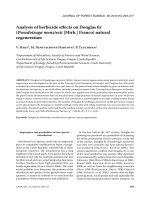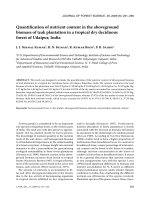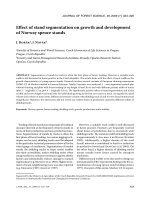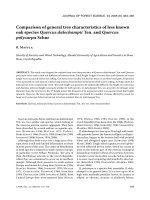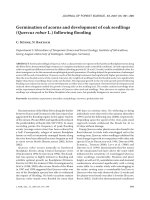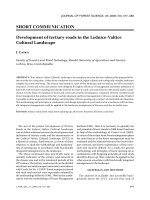Báo cáo lâm nghiệp: "Development of species composition in long term simulations with an individual-tree growth simulator" pps
Bạn đang xem bản rút gọn của tài liệu. Xem và tải ngay bản đầy đủ của tài liệu tại đây (322.88 KB, 7 trang )
194 J. FOR. SCI., 55, 2009 (5): 194–200
JOURNAL OF FOREST SCIENCE, 55, 2009 (5): 194–200
In many regions of Austria former forest man-
agement practices formed even aged pure Norway
spruce stands. Due to different ecological as well as
economical reasons, these stands are now discussed
to be converted into mixed species stands according
to potential natural vegetation type sensu T
(1956). For Austrian forest sites the potential natural
species distribution were described by S
(in L 2001). Another way to get an idea of the po-
tential natural species distribution for a given stand
could be the use of individual tree growth simulators
under the non-management option. Such models can
be used for long term simulations, if they – besides
the individual tree growth models – contain a mor-
tality model and a regeneration or ingrowth model.
Since in the long run, without management, at least
some uneven-aged stages will occur, there should be
preferred simulators which do not rely on the concept
of even-aged stands, i.e. such as the ones which do
not use stand age or site index as input variables.
e objective of this study is to use the data of
secondary conifer stands, apply the individual tree
growth simulator PA (L 2006)
to predict the development of these stands under
the no-management option for 1,000 years without
considering any climate change, and see if the simu-
lated development results in the potential natural
species distribution, according to the expectations
of S (in L 2001).
MATERIAL AND METHODS
e study area
In the forest management district Litschau in
Lower Austria, former stands of the spruce (Picea
abies [L.] Karst.) -fir (Abies alba Mill.) -beech (Fagus
sylvatica L.) ecosystem have been changed by large
clear cuts, planting of Norway spruce, invasion of
Scots pine (Pinus sylvestris L.) and litter raking. e
Development of species composition in long term
simulations with an individual-tree growth simulator
M. H, H. S
Department of Forest and Soil Sciences, Institute of Forest Growth and Yield Research,
BOKU – University of Natural Resources and Applied Life Sciences, Vienna, Austria
ABSTRACT: e spruce-r-beech dominated forest stands in Litschau in the Austrian part of the Bohemian Massif were
converted by former forest management practices into pure Norway spruce stands and are now discussed to be reconverted
into the potential natural vegetation type. e targeted potential natural vegetation type is usually dened by experts in
vegetation sciences. Because meanwhile individual-tree growth simulators are a well acknowledged tool for predicting fu-
ture forest stand development, in this study we investigate if PA can also be used to predict the redevelopment of
managed forest ecosystems into natural forest ecosystems regarding species composition. e development of 23 stands in
Litschau has been simulated over 1,000 years under the “no-management” option. Generally, the simulated species distri-
bution agrees quite well with the expectations of the potential natural vegetation type. However, the predicted amounts of
silver r and maple species are lower than expected, which probably is due to browsing and management eects represented
in the parameterization data for PA.
Keywords: individual-tree growth model; potential natural vegetation type; forest stand development; species distribution
J. FOR. SCI., 55, 2009 (5): 194–200 195
mean annual temperature in this district is 6.6°C and
the annual precipitation about 670 mm at an eleva-
tion of 505 m. e individual-tree and site specific
input data for PA had been determined in
23 sample plots in stands with different proportions
of Norway spruce and Scots pine (Table 1), where
diameter at breast height and tree height for every
tree had been measured in 1982. e sites are located
in the Austrian part of the Bohemian Massif, at an
altitude ranging from 450 m to 550 m, on moist, sub-
strate-induced Podzols and gleyic Podzols, except for
two sites with Mollic and Umbric Gleysols, and on
slopes from 0% to 20%.
e individual-tree growth simulator PA
e parameterization of all models has been based on
data of the Austrian National Forest Inventory (ANFI)
(Forstliche Bundesversuchsanstalt 1981, 1986, 1992,
cited in M, S 1996, 1999, and L-
2002) for a simulation interval of 5 years.
Growth models
PA comprises the individual-tree basal
area increment model according to M and
S (1996) (for coefficients confer H
Table 1. Characterization of the experimental stands in 1982: Age, site class – mean annual increment at age 100 (m
3
/ha)
breast height diameter of tree with mean basal area (dg cm), number of trees (N/ha), basal area (G m
2
/ha), volume (V m
3
/ha)
and the proportion of Picea abies, Pinus sylvestris and other tree species by volume (%). e soil types are marked with
P for the substrate induced Podzol stands, with G for the Mollic and Umbric Gleysol stands and with gP for the gleyic
variants of substrate induced Podzol. e amount of other tree species refers to Abies alba in stand number 12 (
~
) and
to Larix decidua or broadleaf species in the other stands
No.
Soil
type
Elevation Age Site class dg N G V
Picea
abies
Pinus
sylvestris
Other
species
1 gP 450 25 17 11.2 2,572 25 164 81 18 1
2 P 550 110 10 35.5 397 39 466 51 49 0
3 P 550 95 9 32.1 425 34 397 44 56 0
4 P 550 52 11 19.1 1,335 38 360 73 25 2
5 P 550 85 7 24.3 816 38 359 45 55 0
6 P 450 55 12 22.4 862 34 347 49 51 0
7 P 550 50 14 18.9 1,099 31 278 46 48 6
8 P 550 90 9 29.8 495 35 395 68 25 7
9 P 550 65 13 23.1 990 41 449 51 49 0
10 P 450 35 18 17.2 1,483 34 305 73 27 0
11 gP 450 10 25 8.0 3,082 15 76 46 54 0
12 G 450 10 23 8.2 2,339 12 65 59 1 40
~
13 P 550 110 9 35.4 414 41 497 30 70 0
14 P 550 95 9 29.1 603 40 445 56 44 0
15 P 450 90 9 30.6 511 38 443 49 51 0
16 P 550 35 14 13.3 2,402 33 238 72 20 8
17 G 450 105 9 30.8 615 46 530 44 56 0
18 P 450 90 9 28.8 658 43 486 45 55 0
19 P 550 15 17 7.0 4,139 16 66 98 2 0
20 P 550 30 16 11.5 2,523 26 181 74 26 0
21 P 550 10 18 6.4 3,589 12 41 93 6 1
22 P 550 20 17 9.1 2,566 17 75 64 36 0
23 P 550 100 11 32.5 519 43 506 30 70 0
196 J. FOR. SCI., 55, 2009 (5): 194–200
2000), the crown ratio model according to H-
and M (1996) and the individual-tree
height increment model according to N
(2006). e 5-year basal area increment and the
5-year height increment is directly predicted by
species specific functions of site factors, tree size
factors and distance independent competition fac-
tors.
Mortality model
e individual-tree mortality model (M,
S 1999; for coefficients confer H
2000) allows directly predicting the probability (P)
for mortality in a 5-year period:
b
1
(
b
0
+
dbh
+ b
2
× CR + b
3
× BAL + b
4
× dbh
+
P =
(
1 + e
+ b
5
× dbh
2
)
)
–1
(1)
where:
dbh – diameter (cm) at breast height (1.3 m),
CR – crown ratio,
BAL – basal area in larger trees (m
2
/ha),
b
0
–b
5
– species specific coefficients.
e dbh and dbh-square term in this function is
only significant for Norway spruce, which results
in continuously decreasing probability for mortality
with increasing dbh for the other tree species, result-
ing in large trees never dying. erefore the results of
the long term simulations became unreliable. us,
in this study, coefficients b
4
and b
5
of the Norway
spruce model have been used also for the other tree
species to get the expected U-shaped mortality rate
over dbh.
Ingrowth model
Ingrowth in terms of ANFI means that trees exceed
the 5 cm dbh threshold. e ingrowth model accord-
ing to L (2002) consists of species specific
sub-models for direct estimation of (i) the potential
for ingrowth as well as (ii) the number of ingrowth
trees for a 5-year period on the certain plot and (iii)
the species, (iv) the dbh and (v) the height of every
ingrowth tree. e coefficients in model (iii) have
been corrected according to L (personal
communication).
For the present study all models were used de-
terministically, except for sub-model (iv) of the
ingrowth model, which is a transformation of the
probability density function of the Weibull distribu-
tion. A uniformly distributed random number be-
tween zero and one is utilized to attribute a Weibull
distributed dbh to each ingrowth tree. Tree volume
has been calculated according to P
(1974) and S (1988).
Based on tree and site specific data of the 23 sam-
ple plots final simulation runs for 1,000 years without
any management interventions were performed.
Table 2. e tree species proportion in percent of volume/ha for the experts expectation according to S
(in L 2001) and for the average volume/ha over the last 100 years in the simulations with PA on moist
substrate induced Podzol at 450 m a.s.l. (Plot 10), on moist substrate induced Podzol at 550 m a.s.l. (Plot 14), on very
moist and gleyic substrate induced Podzol at 450 m a.s.l. (Plot 11) and on very moist Mollic and Umbric Gleysol at
450 m a.s.l. (Plot 17)
Species Expectation Plot 10 Plot 14 Plot 11 Plot 17
Norway spruce
}
> 40
16.8 18.6 40.7 22.6
Silver fir 1.9 3.7 0.0 0.0
European larch < 20 0.6 0.6 1.2 0.8
Scots pine < 20 0.7 0.6 6.0 10.5
Common beech ≥ 20 53.2 57.8 12.3 10.8
Common ash < 25 6.0 5.5 11.5 9.5
Maple species < 30 0.0 0.0 0.0 0.0
Birch species
}
< 5
2.0 1.8 3.0 2.3
Oak species 0.4 0.2 0.0 0.0
Common hornbeam 9.8 3.2 4.2 5.3
Alder species 8.6 8.0 21.1 38.1
J. FOR. SCI., 55, 2009 (5): 194–200 197
RESULTS AND DISCUSSION
e simulations were run for all 23 plots, however,
in Table 2 and Fig. 1 only 4 plots are highlighted as
example for the rest of plots on similar site condi-
tions and thus with very similar results.
Stand volume
e development of volume per hectare over time
is shown in Fig. 1 for four different sample stands.
All 23 stands show a maximum volume of 868 ±
98.7 m
3
/ha after approximately 98 ± 26 years, corre-
lating highly significant with the site class of Norway
spruce (M 1975) for the respective site as
determined in 1982 (Fig. 2). Afterwards volume de-
creases within the next 260 ± 36 years to a minimum
of 310 ± 61.5 m
3
/ha and in the further development
all plots show three waves in the volume trend and
seem to oscillate around an equilibrium with a wave-
length (distance in years between the last two volume
peaks) of 367 ± 17 years and an amplitude (difference
between the second peak and its subsequent low)
of 160 ± 70.8 m
3
/ha. e average volume over the
last 100 years is between 327 m
3
/ha and 573 m
3
/ha,
varying only marginally over the 100 years (standard
deviations between 4.50 and 35.6 m
3
/ha). e result-
ing volume development with a more or less constant
volume over time is plausible, showing a “wave
motion” like it is expected for the characteristics of
stable ecosystems (G 1982). e volume level
of unmanaged forests ought to be higher and the
wavelength (regeneration period) to be longer as for
Plenter forests (T 1991). M (1976)
mentions a volume per hectare between 300 m
3
/ha
and 700 m
3
/ha for Plenter forests in the Allgäu region
in Germany, depending on site index. Compared to
this, the simulation results would meet the expecta-
tion. Surprisingly, the average volume over the last
100 years occurs to be independent from site class
of the respective stand (Fig. 2). However, it should
be considered that site class was determined in 1982,
when the stands were even-aged and contained only
one or two species, whereas the stands in the simula-
Plot 10
Plot 14
Plot 17Plot 11
Alnus spp. Fagus sylvatica
Betula spp. Pinus sylvestris
Acer spp. Larix decidua
Fraxinus excelsior Abies alba
Carpinus betulus Picea abies
Quercus spp.
1,000
800
600
400
200
0
Volume (m
3
/ha)
1,000
800
600
400
200
0
Volume (m
3
/ha)
2000 2200 2400 2600 2800 3000
Year
2000 2200 2400 2600 2800 3000
Year
Fig. 1. Volume per hectare by species and year on moist, substrate induced Podzol at 450 m a.s.l. (top left), on moist substrate
induced Podzol at 550 m a.s.l. (top right), on very moist and gleyic substrate induced Podzol at 450 m a.s.l. (bottom left) and
on very moist Mollic and Umbric Gleysol at 450 m a.s.l. (bottom right)
198 J. FOR. SCI., 55, 2009 (5): 194–200
tion with PA after 1,000 years are uneven-
aged mixed-species stands.
Species composition
All plots show a steady state species composition
after the year 2400, i.e. after 418 years. The species
proportion in percent of the average volume per
hectare over the last 100 years is given in Table 2
for four selected stands, in comparison with the
expectations of S (in L 2001). On
substrate induced Podzol (Plot 10, Plot 14) com-
mon beech is predominant with an amount of more
than 50%, followed by Norway spruce, alder species
(Alnus spp.) and common ash (Fraxinus excelsior
L.). Silver fir, common hornbeam (Carpinus betu-
lus L.) and birch species (Betula spp.) are present
with an amount smaller than 5%, except for the
stand with lowest elevation (Plot 10), where the
amount of common hornbeam is higher. European
larch (Larix decidua Mill.), Scots pine and oak
species (Quercus spp.) are present with a marginal
amount smaller than 1%. Comparing different soil
types and soil moisture classes, the amount of
common beech is lower, that of Norway spruce,
alder species, common ash and Scots pine is much
higher at the very moist and gleyic Podzol stands
(Plot 11). Silver fir as well as oak species are inexist-
ent on these sites. On Mollic and Umbric Gleysol
(Plot 17) alder species are predominant, followed
by Norway spruce, common beech, Scots pine and
common ash. Silver fir and oak species are inexist-
ent again.
The potential natural vegetation type for the
Litschau region is the sub-hercynic spruce-fir-beech
forest with high proportions of Norway spruce
(K et al. 1994). Compared to the expectation
of S (in L 2001), the proportion of
Norway spruce and silver fir would be too low and
that of common beech would be too high in the
simulation results with PA. e expected
proportions are given very generally for all spruce-
fir-beech types in all growth districts and their alti-
tudinal sub districts and thus characterized by a very
wide range of soil conditions. A spruce-fir-beech
forest as potential natural vegetation is the valid
zonal forest type for the substrate induced Podzol,
but for the Mollic and Umbric Gleysol an azonal
forest type dominated at the given elevation in this
growth district by common alder (Alnus glutinosa
[L.] Gaertn.) is more plausible, which agrees with
our simulation results. e generally low amount
of silver fir could be due to browsing and the eco-
nomical disadvantage of fir wood, reflected in forest
management practice, as they are comprised in the
parameterization database of PA. is could
be similarly true for European larch, whose amount
in the species composition is lower than expected
and maybe caused also by extinction of the natural
occurrences of this species and miscarried crop
growing because of wrong provenance selection.
For Scots pine M (1976) mentions a second
ecological optimum in wet and acidic soil conditions
which would constitute the increased amount of
Scots pine at the stands stronger influenced by gley
dynamics. e increased amount of ash species at
1,000
800
600
400
Volume (m
3
/ha)
8 10 12 14 16 18
Site class of Norway spruce
R
2
= 0.481***
R
2
= –0.045
n.s.
V
max
V
m100
Fig. 2. Regression between the
site class of Norway spruce (es-
timated mean annual increment
at age 100, m
3
/ha) and the maxi-
mum volume/ha (V
max
) and the
average volume over the last
100 years (
V
m100
) respectively.
Stands with age under 25 have
been omitted because of unreli-
able site class estimation
J. FOR. SCI., 55, 2009 (5): 194–200 199
the moister stands also reflects the species’ ecologi-
cal demands in site conditions. Acer campestre L.,
Acer platanoides L. and Acer pseudoplatanus L., the
native maple species in Austria, have rather different
demands in climatic site conditions but, due to the
fact that Acer pseudoplatanus is the only species
showing economical importance, the ANFI sub-
sumed maple species. A generally small amount of
maple in the species composition had been expected
and is plausible because of intolerance of low soil
pH values and the low frost resistance of all maple
species. However, the reduced amount may also be
due to the role of maple species as game forage. e
ANFI also subsumed the native birch species Betula
pendula Roth and Betula pubescens Ehrh. e pres-
ence of birch species in general is plausible due to
its wide ecological range. e potential stronger
presence of Betula pubescens at sites influenced
by ground water may cause the slightly increased
amount in the simulation results. Oak species are
present in the resulting species compositions with
only marginal amounts. e genus is dominant in
eastern Austria together with common hornbeam
and the oak-hornbeam forest is the potential natu-
ral vegetation type for the very south-eastern parts
of the given growth district at elevations between
200 m and 400 m a.s.l. A remarkable amount of
common hornbeam in the simulation results had
been expected because of its less specific demands
in site conditions, in comparison to oak species. e
amount of common hornbeam is higher at dryer
sites and sites at lower elevations.
CONCLUSIONS
Results of long term simulations with PA
meet the expectations for the given growth district
and site conditions rather well. e steady state
wave motion of the volume per hectare as well as its
level is plausible. Regarding tree species the Podzol
stands show a steady state composition dominated
by common beech with admixed Norway spruce
and the Mollic and Umbric Gleysol stands show
a steady state species composition dominated by
common alder with admixed Norway spruce, Scots
pine and common beech. Other native tree species
are present with amounts smaller than ten percent,
depending on site conditions. e resultant species
compositions approximately meet the expectations,
but the amount of silver fir, European larch and
maple species is surely too low, which is caused by
the parameterization data of the ingrowth model in
PA, which represents the impacts of game
animals and management practises.
Acknowledgements
is study was carried out in the framework of the
research project EPIT – Emergent Properties of Indi-
vidual-tree Models funded by the Austrian Science
Fund (FWF, project P18044-B06). e authors are
grateful to J P and various other co-work-
ers for the fieldwork. Many thanks are due to S
V for adjusting PA to the aim of the
research project. We also want to thank two anony-
mous reviewers for their helpful suggestions.
R e fe r en c es
GIGON A., 1982. Typen ökologischer Stabilität mit Beispielen
aus Waldökosystemen. In: MAYER H. (ed.), Urwald-Sym-
posium. IUFRO-Gruppe URWALD: 23–34.
HASENAUER H., 2000. Die simultanen Eigenschaften von
Waldwachstumsmodellen. Berlin, Wien, Paul Parey.
HASENAUER H., MONSERUD R.A., 1996. A crown ratio
model for Austrian forests. Forest Ecology and Manage-
ment, 84: 49–60.
KILIAN W., MÜLLER F., STARLINGER F., 1994. Die forstli-
chen Wuchsgebiete Österreichs. Eine Naturraumgliederung
nach waldökologischen Gesichtspunkten. FBVA Berichte,
82: 60.
LEDERMANN T., 2002. Ein Einwuchsmodell aus den Daten
der Österreichischen Waldinventur 1981–1996. Central-
blatt für das gesamte Forstwesen, 119: 40–76.
LEDERMANN T., 2006. Description of PA for Win-
dows 2.2. In: HASENAUER H. (ed.), Sustainable Forest
Management, Growth Models for Europe. Berlin, Heidel-
berg, Springer: 71–78.
LEXER M.J., 2001. Simulation der potentiellen natürlichen
Vegetation für Österrreichs Wälder. Österreichische Gesell-
schaft für Waldökosystemforschung und experimentelle
Baumforschung. Wien, Universität für Bodenkultur.
MARSCHALL J., 1975. Hilfstafeln für die Forsteinrichtung.
Wien, Österreichischer Agrarverlag.
MAYER H., 1976. Waldbau auf soziologisch-ökologischer
Grundlage. Stuttgart, Jena, New York, Gustav Fischer.
MONSERUD R.A., STERBA H., 1996. A basal area increment
model for individual trees growing in even- and uneven-
aged forest stands in Austria. Forest Ecology and Manage-
ment, 80: 57–80.
MONSERUD R.A., STERBA H., 1999. Modelling individual
tree mortality for Austrian forest species. Forest Ecology
and Management, 113: 109–123.
NACHTMANN G., 2006. Height increment models for indi-
vidual trees in Austria depending on site and competition.
Centralblatt für das gesamte Forstwesen, 123: 199–222.
POLLANSCHÜTZ J., 1974. Formzahlfunktionen der Haupt-
baumarten Österreichs. Österreichische Forstzeitung, 85:
341–343.
200 J. FOR. SCI., 55, 2009 (5): 194–200
SCHIELER K., 1988. Methodische Erfahrungen in Zusam-
menhang mit der Österreichischen Forstinventur. [Master’s
esis.] Wien, Universität für Bodenkultur: 99.
THOMASIUS H., 1991. Fichtenwald-Ökosysteme. In:
SCHMIDT-VOGT H. (ed.), Die Fichte. Bd. II/3. Hamburg,
Berlin, Paul Parey: 1–66.
TÜXEN R., 1956. Die heutige potentielle natürliche Vegeta-
tion als Gegenstand der Vegetationskatierung. Bundesan-
stalt für Vegetationskartierung: 55.
Received for publication September 15, 2008
Accepted after corrections January 20, 2009
Corresponding author:
Dipl. Ing. M H, BOKU – University of Natural Resources and Applied Life Sciences,
Institute of Forest Growth and Yield Research, Department of Forest and Soil Sciences, 1190 Peter Jordanstraße 82,
Vienna, Austria
tel.: + 43 1 47654 4200, fax: + 43 1 47654 4242, e-mail:
Vývoj druhové skladby v dlouhodobých simulacích stromového růstového
simulátoru
ABSTRAKT: Porosty s dominancí smrku, jedle a buku v Litschau v rakouské části Českého masivu byly dřívější
lesnickou praxí přeměněny na stejnorodé smrkové porosty a nyní je uvažováno o jejich přeměně na potenciálně
přirozený typ vegetace. Cílový typ vegetace je obvykle definován experty na rostlinná společenstva. Pro předpověď
budoucího vývoje porostů však začaly být mezitím používány i růstové simulátory. Ve studii jsme zjišťovali, jestli je
model PA také použitelný pro předpověď zpětného vývoje ekosystému hospodářských lesů na přírodní lesní
ekosystémy ve vztahu k dřevinné skladbě. V Litschau byl simulován vývoj celkem 23 porostů v horizontu 1 000 let
„bez zásahu“. Simulovaná dřevinná skladba byla obecně v souladu s očekávanou potenciální přírodní vegetací.
Simulované zastoupení jedle a javoru bylo nižší než očekávané, což bylo pravděpodobně způsobeno díky vlivu okusu
a lesnického hospodaření. Tyto efekty jsou součástí parametrizace dat pro simulátor
PA.
Klíčová slova: stromový růstový model; potenciální přírodní typ vegetace; vývoj lesních porostů; druhová skladba


